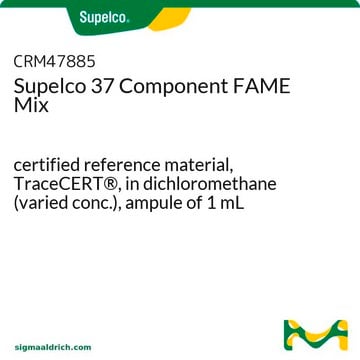추천 제품
Grade
for GC derivatization
Quality Level
설명
Esterification reagent
반응 적합성
reagent type: derivatization reagent
reaction type: Esterifications
포장
pkg of 6 × 5 mL
box of 6 ampules (5mL each)
농도
10 % (v/v) in methanol
SMILES string
OS(O)(=O)=O
InChI
1S/H2O4S/c1-5(2,3)4/h(H2,1,2,3,4)
InChI key
QAOWNCQODCNURD-UHFFFAOYSA-N
유사한 제품을 찾으십니까? 방문 제품 비교 안내
일반 설명
애플리케이션
기타 정보
신호어
Danger
유해 및 위험 성명서
Hazard Classifications
Acute Tox. 3 Dermal - Acute Tox. 3 Inhalation - Acute Tox. 3 Oral - Eye Irrit. 2 - Flam. Liq. 2 - Met. Corr. 1 - Skin Irrit. 2 - STOT SE 1
표적 기관
Eyes
Storage Class Code
3 - Flammable liquids
WGK
WGK 2
Flash Point (°F)
51.8 °F - closed cup
Flash Point (°C)
11 °C - closed cup
가장 최신 버전 중 하나를 선택하세요:
이미 열람한 고객
활성 필터
자사의 과학자팀은 생명 과학, 재료 과학, 화학 합성, 크로마토그래피, 분석 및 기타 많은 영역을 포함한 모든 과학 분야에 경험이 있습니다..
고객지원팀으로 연락바랍니다.










